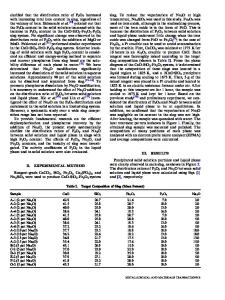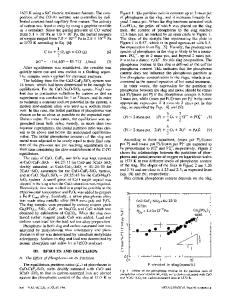Influence of selenium dioxide (SeO 2 ) on properties of bioglass in SiO 2 -Na 2 O-CaO-P 2 O 5 system
- PDF / 2,214,258 Bytes
- 11 Pages / 595.276 x 790.866 pts Page_size
- 55 Downloads / 327 Views
RESEARCH
Influence of selenium dioxide (SeO2) on properties of bioglass in SiO2-Na2O-CaO-P2O5 system Ram Karan 1 & Priyabrata Manna 1 & P. K. Maiti 1 & Kaberi Das 2 Received: 21 February 2019 / Revised: 9 November 2019 / Accepted: 26 February 2020 # Australian Ceramic Society 2020
Abstract The influence of selenium dioxide on bioglass in (45.0-x) SiO2 24.5Na2O 24.5CaO 6.0P2O5 xSeO2 (x = 0.0, 0.5, 1.0, 1.5, and 2.0 wt%) system was investigated by preparing the glass through conventional melting and annealing method. The glass transition temperature (Tg), crystallization temperature (Tc), and density of prepared glasses were measured by differential thermal analysis and Archimedes’ principle respectively. The structural and microstructure analyses of glasses were characterized by Raman spectroscopy, Fourier transformed infrared (FTIR) spectroscopy, and scanning electron microscopy (SEM) with energy dispersive X-ray analysis (EDX). The formation of hydroxy apatite carbonate (HCA) layer for glasses was investigated by Raman spectroscopy, FTIR, SEM with EDS, pH measurement, ion concentrations analysis, and (%) weight loss after immersion in simulated body fluid (SBF) for 10 h to 14 days at 37.5°C. Experimental results showed that SeO2 substitution for SiO2 in the glass had increased glass density and molar volume whereas network connectivity was decreased. The addition of selenium oxide reduced the glass transition temperature and also crystallization temperature. The FTIR study of glass confirmed the P–O bonding after immersion for 14 days in SBF, which was also identified in the Raman spectroscopy. SEM of the 14 days immersed sample showed the formation of cauliflower like morphology of HA particles on the glass. pH and ion concentrations analysis also confirmed the formation of HCA layer after 14 days of immersion in SBF. Keywords Bioglass . Selenium substitution . Molar volume . Network connectivity . Raman spectroscopy
Introduction Bioactive glasses (BGs) degrade in physiological solutions, forming a layer of hydroxy carbonate (HCA) apatite layer which is very similar to mineral phase of bones. This helps to form an intimate bond between glass and living tissue. The first BG was developed by Hence in the late 1960s and has been clinically used in 1985 [1, 2]. Since then, several new bioactive glass compositions have been developed varying different component of the base (45S5) glass. At present, various types of bioactive glasses are under research and development and more complex compositions * Ram Karan [email protected] 1
Department of Chemical Technology, University of Calcutta, 92, A. P. C. Road, Kolkata 700 009, India
2
Department of Ceramic Technology, Government College of Engineering and Ceramic Technology, 73, Abinash Chandra Banerjee Lane, Kolkata 700 010, India
have been designed to enhance bioactivity of the materials. A great effort is being put into the understanding of the mechanism and factors governing properties. Selenium is an essential trace element of a key antioxidant enzyme
Data Loading...











